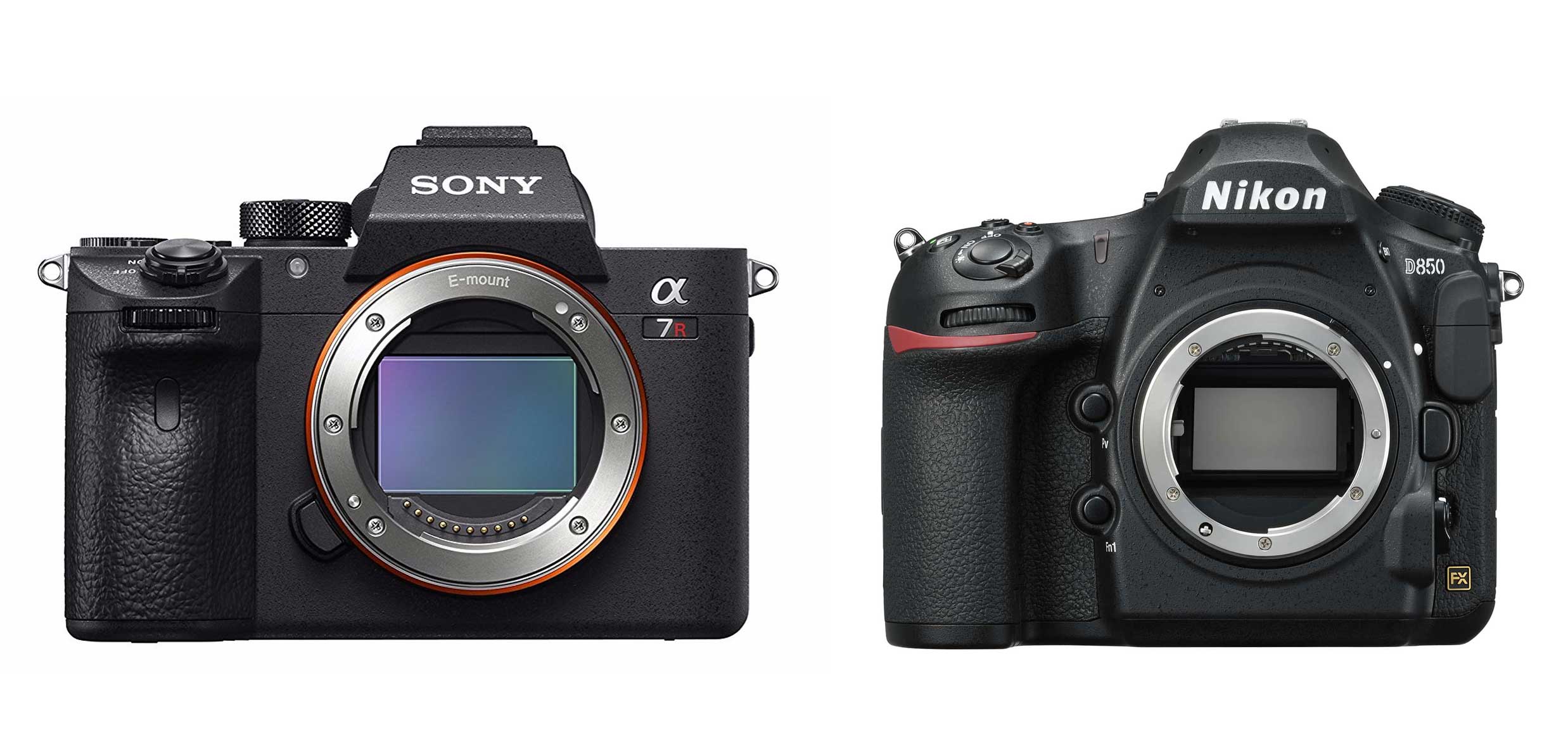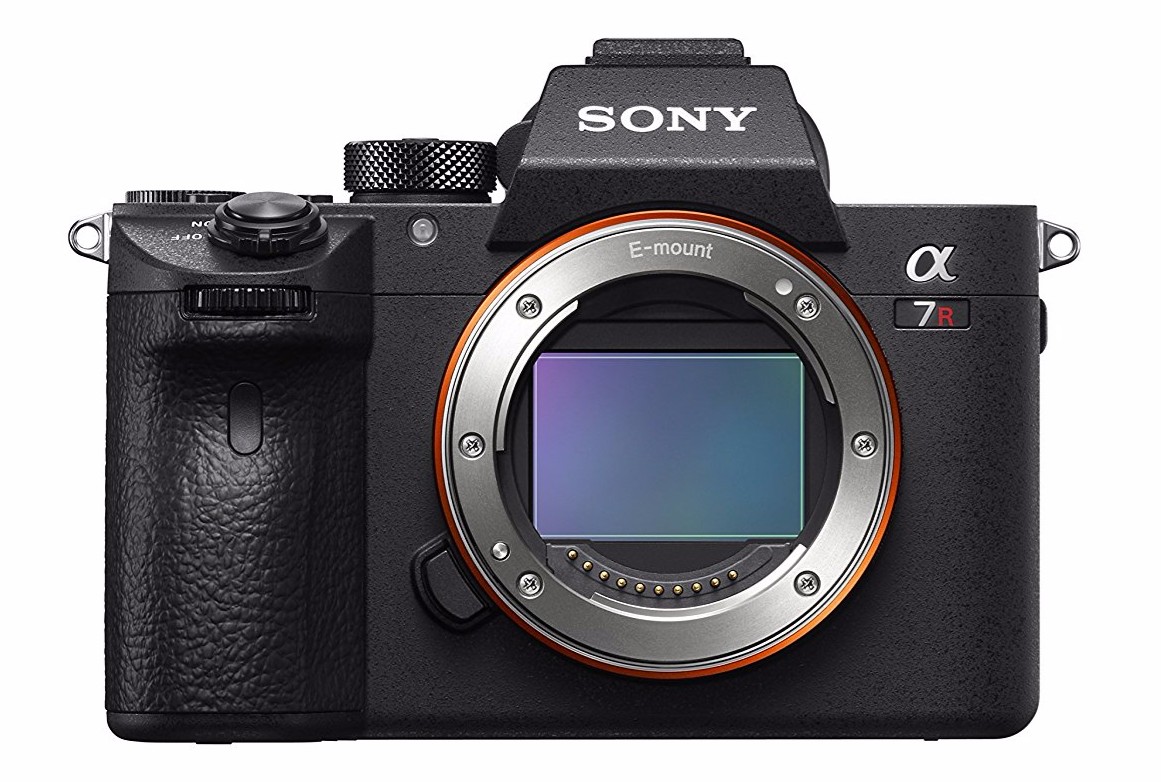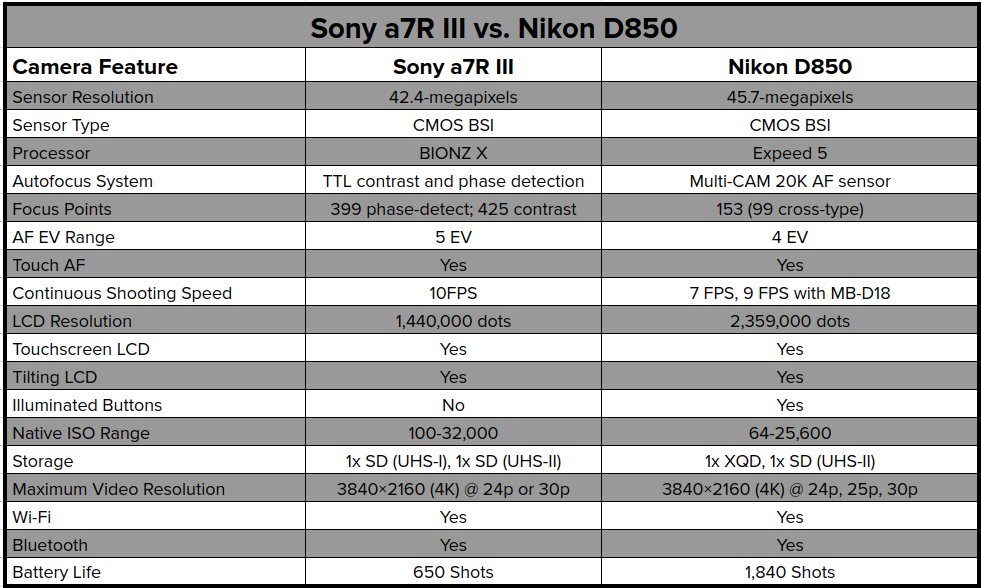Talk about a battle for the ages...
It was just a few weeks ago that Nikon released the incredible D850.
That rig has already garnered a reputation as being one of Nikon's best cameras of all time. Check out Nikon D850 review by PhotographyTalk.com.


Yet here we are a few weeks later, and Sony is trying to steal a bit of the D850's thunder with the release of the a7R III.
Let's see how these two incredible cameras matchup.
Essential Specifications - Nikon D850

- 45.7-megapixel BSI CMOS FX sensor
- Expeed 5 image processor
- 153-point autofocus system
- ISO range 64-25,600 (expandable to 102,400)
- 7fps burst shooting speed (9fps with optional battery grip)
- 4K video at 30fps and 1080p video at 120fps
At quick glance, you can see just how powerful the D850 really is.
Though the 45.7-megapixel sensor doesn't have the resolution of the likes of the Canon 5DS, it still manages to produce the best image quality around, at least according to DxOMark, which gave the D850 a 100/100 score for its sensor.
The fact that the sensor is back-illuminated helps, but there's much more to the D850 than its amazing image quality.

The Expeed 5 image processor is lightning fast, making quick work of tasks.
The improved autofocus system not only has more AF points, but it also has a much-improved detection range as well. Combined with a faster continuous shooting rate of 7fps (9fps with an optional battery grip), you have camera primed and ready for action photography.
This camera also has seen improvements in the viewfinder, which is larger, the processor, which is faster, and the battery, which has improved life.
There's even a silent shutter, support for XQD and UHS-II SD cards, a tilting touchscreen LCD, and 4K video.
It's got some even fancier features, too...
That includes in-camera RAW processing, built-in focus stacking, and built-in focus peaking as well. Speaking of RAW, this camera can handle up to 170 RAW files in its buffer.
Add in Wi-Fi, Bluetooth, built-in timelapse video shooting, and illuminated buttons, and you have the makings of one hell of a camera.
See these features and more in the video above by PhotoRec TV.
Learn More:
Essential Specifications - Sony a7R III

- 42.4-megapixel BSI CMOS full frame sensor
- BIONZ X image processor
- 399-point autofocus system
- ISO range 50-32,000 (expandable to 102,400)
- 10fps burst shooting speed
- 4K video at 24fps or 30fps and 1080p at 120fps
Based on the specs outline above, it's plain to see that Sony came to play with the big boys.
Though DxOMark hasn't tested the a7R III as of this writing, my guess is that it's going to garner among the highest scores ever recorded.
I base that assumption on the fact that its predecessor, the a7R II, used to hold the title for the best sensor - that is, until the Nikon D850 came along.

The a7R III and the D850 are comparable in many other ways as well.
Both have 4K video, excellent ISO ranges that are expandable to 102,400, and cutting-edge processors that make quick work of tasks.
But there's a couple of ways that the a7R III might have a leg up on the D850...
The first is the burst shooting speed, which sits at an astonishing 10fps. There is simply no beating this thing when it comes to speed.
The other area where the Sony a7R III shines is its autofocus system, which is equipped with a ridiculous 399 phase-detect autofocus points and 425 contrast autofocus points.
According to Sony, that makes the a7R II two times as fast as the a7R II when shooting in dim lighting.
What all that means is that you can shoot 10 frames per second in RAW or in JPEG while having the luxury of autofocus tracking at the same time.
The kicker is that the camera does all that with zero shutter blackout.
You can see these and other features in the hands-on review of the a7R III in the video above by Kai W.
Learn More:
Comparing the Nikon D850 and the Sony a7R III

Clearly, these cameras both offer tons of features for photographers. The question is, which one will reign supreme?
That's a tough question to answer, even if we break these cameras down by their primary features.
The Nikon D850 is the winner in the sensor department. With a perfect score from DxOMark, Sony can't outdo that performance. It also offers a much wider selection of lenses and feels better in your hand.
On the other hand, the Sony a7R III takes the cake in the continuous shooting speed. And with a more robust autofocus system that has more AF points, eye detection capabilities, and face detection capabilities, the Sony wins in AF performance as well.
Both cameras offer 4K video, fast processing speeds, and excellent viewfinders. They're both weather-sealed and both have tilting touchscreen LCDs. Battery life is comparable as well, which is actually a big win for Sony, which offered abysmal battery performance in the a7R II.
Both cameras also offer a similar price tag, coming in at around $3,200 for the body.
Ultimately, these cameras are so powerful and so versatile, that you'd be hard-pressed to find something that gives you better performance.
That means that if you're a Nikon shooter, the Sony likely won't convince you to jump ship. The same goes for Sony shooters switching to Nikon. It just isn't likely to happen.
So, if you're wondering which of these cameras is the cream of the crop, the answer is both.
If you've already invested into Nikon, stick with it and upgrade to the D850. If you're in the Sony space, upgrade to an a7R III. Either way, you'll be pleased with the camera you get.
For a more in-depth comparison of the Nikon D850 and the Sony a7R III, check out the video above by Tony and Chelsea Northrup.
This article about Sony A7R III vs Nikon D850 camera was first published on our website https://www.photographytalk.com/photography-articles/7988-sony-a7r-iii-vs-nikon-d850-which-is-best